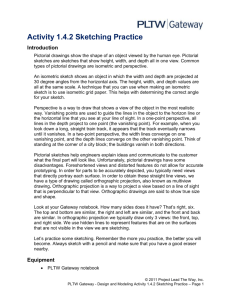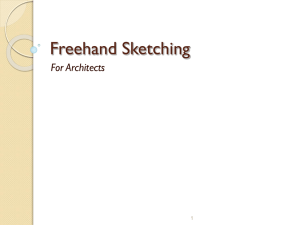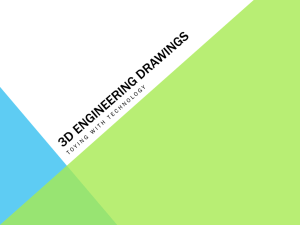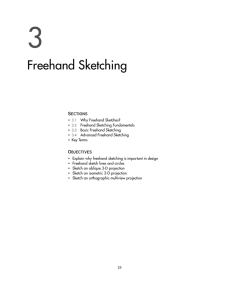Lecture_2
advertisement
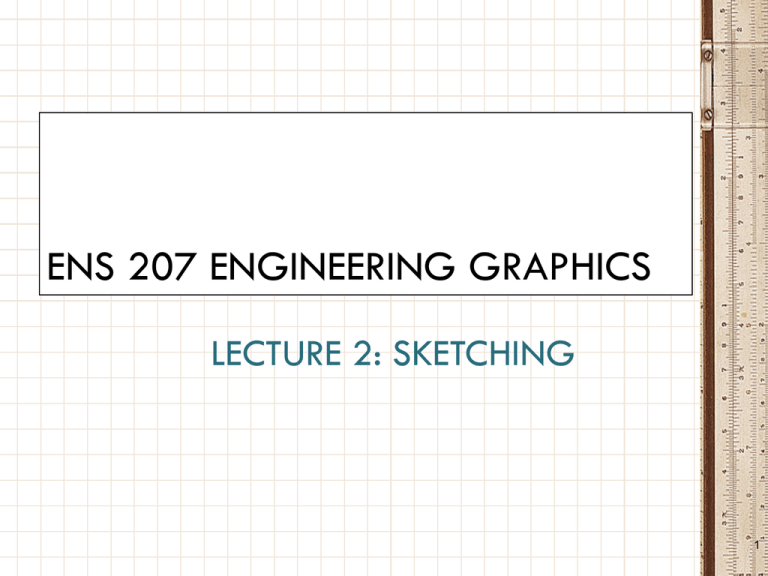
ENS 207 ENGINEERING GRAPHICS LECTURE 2: SKETCHING 1 Freehand Sketching Freehand sketches are a helpful way to organize your thoughts and record ideas. They provide a quick, low-cost way to explore various solutions to design problems so that the best choices can be made. TECHNIQUE OF LINES The chief difference between a drawing and a freehand sketch lies in the character or technique of the lines. A good freehand line is not expected to be as rigidly straight or exactly uniform. A good freehand line shows freedom and variety, whereas a line drawn using CAD or instruments should be exact. line patterns Lineweights Even in freehand drawings, thick lines should be twice the width of thin lines. Thicknesses do not have to be exact, but there should be an obvious difference between thick and thin lines. Because visible lines and cuttingplane lines are the two thick line patterns, other lines should be distinctly thinner in comparison. To draw thick and thin lines freehand, you might like to keep two pencils handy, one that is razor sharp for thin lines and another that is dulled, to create thicker lines. As the sharp point becomes dulled, switch it with the dull pencil, and sharpen the other, so that there is always one sharp and one dulled point ready to use. FREEHAND LINES The main difference between an instrument or CAD drawing and a freehand sketch is in the appearance of the lines. A good freehand line is not expected to be precisely straight or exactly uniform, as is a CAD or instrument-drawn line. Freehand lines show freedom and variety. Freehand construction lines are very light, rough lines. All other lines should be dark and clean. Edges and Vertices Edges An edge of the solid is formed where two surfaces intersect. Edges are represented in drawings by visible or hidden lines. Vertices A vertex (plural, vertices) of a solid is formed where three or more surfaces intersect.. Points A point is used to represent a location in space but has no width, height, or depth. For Example: 1. Visible 2. Hidden 3. Center 7 Horizontal line Vertical line Small Circle Method 1 : Starting with a square 1. Lightly sketching the square and marking the mid-points. 2. Draw light diagonals and mark the estimated radius. 3. Draw the circle through the eight points. Step 1 Step 2 Step 3 Arc Method 1 : Starting with a square Method 2 : Starting with a center line Example 12 PROPORTIONS Sketches should be proportional. A square should look like a square, and a rectangle like a rectangle. Graph paper is very helpful in sketching proportionally, but it is still sometimes difficult to be accurate even with graph paper. CURVES Curved shapes are best sketched by first defining points along the curve, then lightly sketching the curve between the points. Circles and Ellipse An ellipse can be sketched by first sketching a perpendicular axis, then locating four marks on the centerlines that are approximately equal to major and minor axis distances. Sketch a light curve, make any corrections necessary, and darken in the elliptical shape. Introduction to Isometric Projection CUBE • Isometric means equal measure • All planes are equally or proportionately shortened and tilted • All the major axes (X, Y, Z) are 120 degrees apart AU 2005 16 Making an Isometric Sketch • Defining Axis 60o 30o 30o Isometric Axis AU 2005 17 60o Three planes The three planes of an isometric axis are defined as the left, right, and top planes, respectively Making an Isometric Sketch • Axis Convention Height Choose the longest dimension to be the width (or the depth) for optical stability Width Front view AU 2005 19 Depth Isometric Axis Convention Object for Practice AU 2005 20 Blocking in the Object Begin with Front Face Front Face Height Width AU 2005 21 Blocking in the Object: Add Side Face Side Face Height AU 2005 22 Depth Blocking in the Object: Add Top Face Top Face AU 2005 23 Adding Detail Cut Outs – Part 1 AU 2005 24 Adding Detail Cut Outs – Part 2 AU 2005 25 Adding Detail Cut Outs – Part 3 AU 2005 26 Darken Final Lines - Part 4 Note: All visible edges will be darkened AU 2005 27 PLANNING YOUR DRAWING OR SKETCH When laying out a drawing sheet, you will need to consider: • the size and scale of the object you will show • the sheet size • the measurement system (units) for the drawing • the space necessary for standard notes and title block.
